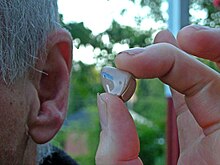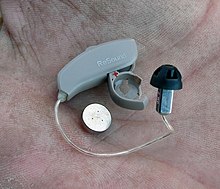Hearing aid
small sound amplifiers worn in the ear (ITE) to compensate for hearing loss
A hearing aid is a small electrical machine which fits in or behind a person's ear. The purpose of a hearing aid is to make sounds louder so the deaf person can hear spoken words and other sounds.




The two most common types of modern hearing aids are behind the ear aids and in the ear aids.
Before hearing aids were invented, people used "ear trumpets" also called ear horns.[1][2]
Types of hearing aids change
There are many different types of hearing aids. They are good for different users depending on lifestyle and how much help they need to hear. An audiologist can help make hearing aids work even better for a user by customising them.
- In-The-Canal (ITC) - the smallest type of hearing aid, these are made to fit inside the ear canal and can be used by people with mild to moderate hearing loss
- In-The-Ear (ITE) - these are slightly larger than the ITC aids and fit inside the outer ear instead of the canal. These can be used by people with mild to severe hearing loss
- Behind-The-Ear (BTE) - sit behind the ear and connect to a mould placed in your ear through a tube. This type of aid is usually the largest but can be used by almost anyone with hearing loss and has many different functions
References change
- ↑ Comparison of Hearing Aids Over the 20th Century. Ear & Hearing. 21(6):625-639, December 2000. Bentler, Ruth A.; Duve, and Monica R.
- ↑ http://www.hearingcenter.com/Questions/Q_ear-horn.html Archived 2008-07-24 at the Wayback Machine Ear Horn Q&A. Accessed 6 Dec 2007.
Other websites change
- NIH Archived 2016-05-09 at the Wayback Machine Information from the National Institutes of Health (NIH).
- Better Hearing Institute Non-profit website containing articles and information on hearing loss and hearing loss solutions.
- Hearing Loss Association of America Consumer-based self-advocacy group, information.
- Hearing Aid Blog Archived 2010-12-07 at the Wayback Machine Hearing aids reviews and information.
- Consumer Hearing Aids Resource Information and resources on hearing aid manufacturers
- Hard of Hearing Advocates Archived 2009-06-05 at the Wayback Machine Non-profit foundation dedicated to helping those with hearing loss
- American Academy of Audiology Find an Audiologist, and get more information on hearing loss.
- British Society of Hearing Aid Audiologists Find A Hearing Aid Dispenser in the UK.
- Irish Society of Hearing Aid Audiologists Find a Hearing Aid Dispenser in Ireland.
- Canadian Academy of Audiology Consumer information on hearing loss, professional resources.
- American Hearing Research Foundation The American Hearing Research Foundation which funds significant research in hearing and aims to help educate the public in the United States.
- Action On Hearing Loss (formerly RNID) Information and resources about hearing loss.